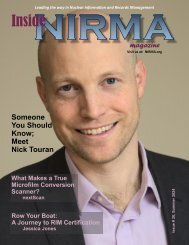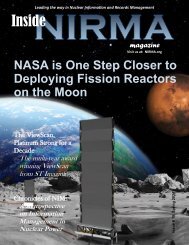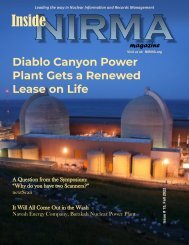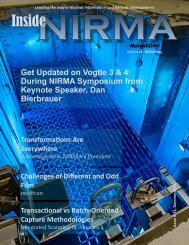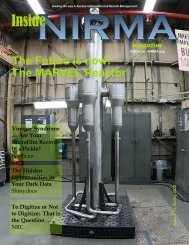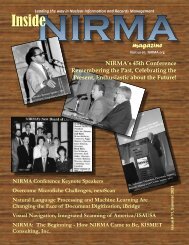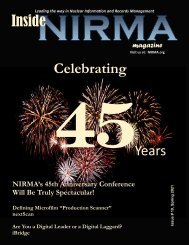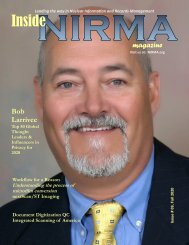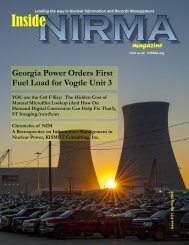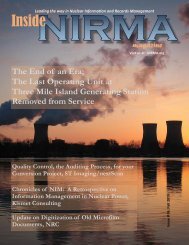You also want an ePaper? Increase the reach of your titles
YUMPU automatically turns print PDFs into web optimized ePapers that Google loves.
<strong>Inside</strong><br />
Leading the way in Nuclear Information and Records Management<br />
magazine<br />
Visit us at: <strong>NIRMA</strong>.org<br />
Eugene Yang<br />
Principal Consultant with<br />
KISMET Consulting Inc.,<br />
Recipient of:<br />
⬧1996 <strong>NIRMA</strong> Scholarship<br />
Award,<br />
⬧1999 <strong>NIRMA</strong> Hans Ebner<br />
Memorial Award,<br />
⬧2002 <strong>NIRMA</strong> Lifetime<br />
Membership Achievement,<br />
Author, & <strong>NIRMA</strong><br />
Conference<br />
Presenter<br />
Critical to be Digital<br />
Digital more critical in a pandemic world.<br />
What you need to know to fix that<br />
ST Imaging/nextScan<br />
Microfilm Conversion—Do It Right the<br />
First Time<br />
e-ImageData’s DRFT Scanning<br />
Technology is the latest trend in<br />
microfilm digital conversion<br />
Issue # 08, <strong>Summer</strong> <strong>2020</strong>
Contents<br />
<strong>Summer</strong> <strong>2020</strong><br />
5<br />
9<br />
Critical to be Digital<br />
Digital more critical in a pandemic world. What you need to<br />
know to fix that.<br />
By Matt Anderson, Vice President of Marketing, ST Imaging / nextScan<br />
Microfilm Conversion—Do It Right the First Time<br />
e-ImageData’s DRFT Scanning Technology is the latest trend<br />
in microfilm digital conversion<br />
By Todd Kahle, Vice President of e-ImageData<br />
7<br />
12<br />
14<br />
Commenting on NRC Draft Regulations and Guidance<br />
Documents<br />
By Margie Janney, CRM/NS/FED<br />
The Importance of Information Governance & Preservation<br />
By Bob Larrivee, President of Bob Larrivee Consultancy<br />
Chronicles of NIM: A Retrospective on Information<br />
Management in Nuclear Power<br />
By Eugene Yang, KISMET Consulting, Inc.<br />
2 <strong>Summer</strong> <strong>2020</strong> <strong>NIRMA</strong>.org <strong>Inside</strong> <strong>NIRMA</strong>
<strong>Summer</strong> <strong>2020</strong><br />
CONTENTS<br />
in every issue<br />
FROM THE PRESIDENT—6<br />
TREASURER REPORT—10<br />
VICE PRESIDENT REPORT—11<br />
M&MBU NEWS—16<br />
PDBU NEWS—17<br />
INDUSTRY NEWS—18<br />
Editors<br />
Neal and Sandra Miller<br />
DevereauxInc@outlook.com<br />
Advertising<br />
Neal.F.Miller@gmail.com<br />
<strong>NIRMA</strong> Headquarters<br />
Sarah Perkins<br />
<strong>NIRMA</strong> Administrator<br />
245 Sunnyridge Ave., #41<br />
Fairfield, CT 06824<br />
nirma@nirma.org<br />
<strong>Inside</strong> <strong>NIRMA</strong> <strong>NIRMA</strong>.org <strong>Summer</strong> <strong>2020</strong> 3
Can’taccessphysicalrecordsduringtheCoronaviruspandemic?<br />
Productivitydoesn’thavetocometoascreechinghalt.<br />
AccessMicrofilm Records,Anywhere.<br />
Searchfor<br />
Microfilm Rol<br />
Navigateto<br />
Microfilm Record<br />
DistributeDigital<br />
Microfilm Record<br />
VirtualFilm ®<br />
VirtualFilm®isabudget-friendlydigitalviewingsoftwareforadatabaseofscanned<br />
microfilm.VirtualFilm®isidealforitscostsavingbenefitsandeasysearchand<br />
retrievalcapabilities.WithVirtualFilm®microfilm recordscanbeviewedfrom any<br />
PCworkstation,desktoporlaptopcomputer—anywhere,anytime,makingremote<br />
accesstorecordseasierthanever!<br />
Getintouchwiththeexpertstoday.<br />
Learnmoreat:<br />
www.nextscan.com<br />
+12085144000<br />
sales@nextscan.com
G<br />
Critical to be Digital<br />
Digital more critical in a pandemic world.<br />
What you need to know to fix that.<br />
By Matt Anderson,<br />
Vice President of Marketing, nextScan<br />
T<br />
he world has been turned<br />
upside down in <strong>2020</strong>. The<br />
COVID-19 pandemic has<br />
shaken us to our core and has forced<br />
many of us into a new way of<br />
working. Thankful to be “essential”<br />
and that we still have our jobs, many<br />
of us must reinvent the way we<br />
perform our tasks.<br />
Previously, working from home<br />
seemed somewhat unprofessional or<br />
something from a different<br />
generation. But when forced into<br />
conforming into a new way of<br />
getting the job done, our human<br />
ingenuity took over and we were<br />
able to adapt.<br />
How have you had to adapt?<br />
While at first the video chatting and<br />
Zoom calls seemed very awkward<br />
and foreign. After some time, a<br />
familiarity has emerged, we know<br />
what to expect. Professionally,<br />
Microsoft has developed many<br />
platforms to allow organizations to<br />
work virtually together. Teams<br />
allows for the collaboration between<br />
team members online. OneDrive<br />
was developed by Microsoft to<br />
provide access to anyone’s drive of<br />
documents online. No need to lug<br />
around an external hard drive or<br />
multiple USB drives. Microsoft also<br />
developed Sharepoint to allow files<br />
to be shared<br />
virtually between<br />
team members.<br />
The accessibility of<br />
these virtual<br />
documents creates the virtual office<br />
environment and allows the work to<br />
continue.<br />
So how do you access the files<br />
that pertained to completing your<br />
job? Where are those assets? Many<br />
documents we had grown accustom<br />
to accessing were no longer available<br />
to us during the pandemic. Those<br />
physical assets would be very<br />
Continued on next page.<br />
5 <strong>Summer</strong> <strong>2020</strong> <strong>NIRMA</strong>.org <strong>Inside</strong> <strong>NIRMA</strong>
STimaging<br />
next can<br />
S<br />
valuable if they were able to be made available<br />
electronically. In order to work remotely you will need<br />
the tools and infrastructure to do so.<br />
Today there is VirtualFilm software that allows users<br />
to work remotely with virtual ribbons of microfilm just<br />
how they would have worked with the real rolls of<br />
In the times of<br />
uncertainty, we want to<br />
be there to help restore<br />
some normalcy. And if<br />
that is through<br />
accessing your records,<br />
we want to be able to<br />
make that happen for<br />
you.<br />
microfilm, without having access to the physical roll.<br />
Here is how it works. Once a roll of microfilm has been<br />
digitized, it is placed onto a secure server or into the<br />
cloud. The next time a request comes in for<br />
information, instead of accessing the physical roll, a<br />
remote user simply logs onto the server to access the<br />
virtual roll. Now they quickly navigate to the desired<br />
information. With the information located, the user<br />
downloads the digital file and is able to share. Anyone<br />
with the proper credentials can access virtual rolls of<br />
microfilm. VirtualFilm also has the ability to store<br />
images from paper and other electronic document<br />
sources providing unified content management and<br />
digital reformatting capabilities to your existing digital<br />
archives.<br />
Working in the time of this modern pandemic, and<br />
what the future may hold, is a challenge to us all as we<br />
learn to juggle all aspects of our lives. Being an<br />
“Essential Worker” has its demands. In the times of<br />
uncertainty, we want to be there to help restore some<br />
normalcy. And if that is through accessing your records,<br />
we want to be able to make that happen for you.<br />
From the President<br />
Michelle M. Smith<br />
T<br />
he conference is fast approaching and we<br />
have elected to host a hybrid conference this<br />
year. What does that mean to you as a<br />
<strong>NIRMA</strong> member? You will have the option<br />
to attend the conference in Las Vegas at the JW<br />
Marriot or attend virtually. The hotel is working<br />
diligently to ensure the safety of our members.<br />
The board of directors will be present at the JW<br />
Marriot to ensure a successful conference. We have a<br />
wonderful lineup of presenters that will be discussing<br />
issues relevant to the Nuclear Industry and present us<br />
with challenges that will help define our future. As<br />
the nuclear industry continues to evolve, our facilities<br />
will continue to look for efficiencies to drive changes<br />
to help the nuclear economy.<br />
One method of ensuring the continued growth of<br />
our industry is to share strategies and processes with<br />
others. <strong>NIRMA</strong> plays an important role in sharing<br />
information with our industry. Recently, we shared<br />
lessons learned from different utilities as they address<br />
the COVID-19 pandemic. <strong>NIRMA</strong> reached out and<br />
solicited information that was valuable to our<br />
industry. We will have sessions on lessons learned<br />
and how we can continue to implement process<br />
improvements in the area of digital technology that<br />
will continue to drive change in our industry.<br />
Now is the time to register for the conference to<br />
ensure your spot. Looking forward to hearing from<br />
you soon.<br />
6 <strong>Summer</strong> <strong>2020</strong> <strong>NIRMA</strong>.org <strong>Inside</strong> <strong>NIRMA</strong>
COMMENTING ON NRC DRAFT<br />
REGULATIONS AND GUIDANCE<br />
DOCUMENTS<br />
D<br />
id you know that any member of the<br />
public can comment on NRC draft<br />
regulations and guidance documents,<br />
including you?<br />
The NRC’s regulatory process includes five main<br />
components:<br />
(1) developing regulations and guidance for our<br />
applicants and licensees,<br />
(2) licensing or certifying applicants to use nuclear<br />
materials or operate nuclear facilities or<br />
decommissioning that permits license<br />
termination,<br />
(3) overseeing licensee operations and facilities to<br />
ensure that licensees comply with safety<br />
requirements,<br />
(4) evaluating operational experience at licensed<br />
facilities or involving licensed activities, and<br />
(5) conducting research, holding hearings to address<br />
the concerns of parties affected by agency<br />
decisions, and obtaining independent reviews to<br />
support our regulatory decisions.<br />
The following developmental activities under the<br />
first component are defined as:<br />
• Rulemaking: developing and amending<br />
regulations that licensees must meet to obtain<br />
or retain a license or certificate to use nuclear<br />
materials or operate a nuclear facility;<br />
• Guidance: developing and revising guidance<br />
documents, such as regulatory guides, standard<br />
review plans, and NRC's Inspection Manual to<br />
aid licensees in meeting safety requirements;<br />
• Generic Communications: information about<br />
regulatory requirements, some of which require<br />
response; and<br />
• Standards: working with industry standards<br />
organizations to develop consensus standards<br />
associated with systems, equipment, or<br />
materials used by the nuclear industry so that<br />
these standards may be referenced in NRC<br />
regulations or guidance<br />
The NRC affords the public<br />
opportunities to comment on proposed rules<br />
and policies, licensing actions, and draft technical<br />
documents. Toward that end, the NRC announces<br />
public comment opportunities in the Federal Register,<br />
through press releases, and on our Documents for<br />
Comment page. All public comments are placed in the<br />
NRC’s Agencywide Documents Access and<br />
Management System (ADAMS) as public comments and<br />
into a docket for the action on Regulations.gov.<br />
If you visit our website, www.nrc.gov, and click on<br />
the tab for “Public Meetings and Involvement”, and<br />
then the “Documents for Comment” link, you will see<br />
all of the documents that are open for public comment.<br />
Those documents include:<br />
• Rulemaking-Related Documents<br />
• License Applications/Amendments<br />
• Generic Communications<br />
• Draft Regulatory Guides for Public Comment<br />
• Draft NUREG-Series Publications<br />
• Policy Statements<br />
• Draft Interim Staff Guidance<br />
• Information Collections<br />
• Other Documents for comment<br />
You can even subscribe to page updates by clicking<br />
on the envelope immediately above the “Documents for<br />
Comments” title on the page.<br />
The NRC considers public involvement in, and<br />
information about, our activities to be a cornerstone of<br />
strong, fair regulation of the nuclear industry. We<br />
recognize the public's interest in the proper regulation<br />
of nuclear activities and provide opportunities for<br />
citizens to be heard. We encourage your participation<br />
and comments.<br />
<strong>Inside</strong> <strong>NIRMA</strong> <strong>NIRMA</strong>.org <strong>Summer</strong> <strong>2020</strong> 7
Conver t with the Pros<br />
SLEEK. SMART.<br />
SURPRISINGLY AFFORDABLE.<br />
Featuring exclusive time-saving<br />
technology to digitize your records<br />
for a fraction of the cost.<br />
Schedule a virtual demo today<br />
and get free shipping!<br />
CALL 1-800-251-2261<br />
Promo code:<br />
FREESHIP20<br />
e-imagedata.com<br />
THE MICROFILM SCANNERS OF CHOICE WORLDWIDE
Microfilm Conversion—<br />
Do It Right the First Time<br />
e-ImageData’s DRFT Scanning Technology is the latest<br />
trend in microfilm digital conversion<br />
I<br />
t was once thought that ribbon<br />
scanning was the only way to<br />
ensure that 100% of the<br />
images on a roll of microfilm<br />
would be captured. Since the recent<br />
introduction of e-ImageData’s Do it<br />
Right the First Time (DRFT)<br />
scanning technology, this archaic<br />
thinking has fallen by the wayside.<br />
Ribbon scanning is a “do-it-quick,<br />
fix-it-later” process that was<br />
considered to be the fastest way to<br />
do microfilm digital conversion. We<br />
all know the old adage – “There’s<br />
never enough time to do it right but<br />
always enough time to do it over”.<br />
Such is the case with ribbon<br />
scanning. Although the scanning step<br />
in ribbon scanning is fast, the<br />
subsequent post processing steps of<br />
straightening, cropping, adjusting,<br />
and rescanning can take many times<br />
longer than the scanning step.<br />
e-ImageData’s ScanPro® All-In-<br />
One conversion scanner features<br />
DRFT scanning technology that<br />
ensures images are straightened,<br />
cropped and adjusted on the fly<br />
eliminating the post processing steps<br />
required with ribbon scanning. The<br />
All-In-One was developed to fill the<br />
need in the marketplace for a<br />
microfilm digital conversion tool that<br />
is versatile (scans both roll film and<br />
fiche), simple to operate, saves time,<br />
and at a cost that is a small fraction<br />
of that of ribbon scanning<br />
equipment.<br />
“e-ImageData's DRFT<br />
scanning technology is a<br />
paradigm shift in digital<br />
microfilm conversion.<br />
What once required<br />
hardware and software<br />
costing $50,000 and more<br />
is now available in a<br />
ScanPro All-In-One<br />
costing less than $7,500.<br />
Stay connected with us to<br />
see our progress as we<br />
will soon have a webbased<br />
viewing option that<br />
will allow web access to<br />
all your scanned<br />
document images.”<br />
Todd Kahle,<br />
Vice President of e-ImageData.<br />
With DRFT scanning technology,<br />
ScanPro All-In-One users enjoy:<br />
√ Total Image Capture | Scans<br />
100% of the images<br />
√ Saves Times | Your job is 99%<br />
done<br />
√ Saves Money | A small fraction<br />
of the cost of ribbon scanning<br />
equipment<br />
√ Versatile | Scans roll film and<br />
fiche<br />
√ Secure | Portable, allowing<br />
secure in-house scanning of<br />
confidential documents<br />
By Todd Kahle,<br />
Vice President of e-ImageData<br />
“e-ImageData's DRFT scanning<br />
technology is a paradigm shift in<br />
digital microfilm conversion. What<br />
once required hardware and software<br />
costing $50,000 and more is now<br />
available in a ScanPro All-In-One<br />
costing less than $7,500. Stay<br />
connected with us to see our<br />
progress as we will soon have a webbased<br />
viewing option that will allow<br />
web access to all your scanned<br />
document images,” says Todd Kahle,<br />
Vice President of e-ImageData.<br />
Myths in the Microfilm<br />
Digital Conversion World<br />
Myth #1: Ribbon scanning is<br />
the only way to ensure all<br />
images are scanned.<br />
Reality: e-ImageData’s DRFT<br />
scanning technology not only scans<br />
100% of the images on a roll of film,<br />
but it also straightens, crops, and<br />
adjusts brightness and contrast for<br />
Continued on next page.<br />
<strong>Inside</strong> <strong>NIRMA</strong> <strong>NIRMA</strong>.org <strong>Summer</strong> <strong>2020</strong> 9
each image on the fly, eliminating the time-consuming<br />
and costly manual fixes.<br />
Myth #2: Ribbon scanning reliably captures<br />
all images.<br />
Reality: Although ribbon scanning does scan 100% of<br />
the images on a roll of film, the entire roll is scanned<br />
using a fixed brightness and contrast setting.<br />
Consequently, due to the inevitable contrast and<br />
brightness variations of document images on film,<br />
ribbon scanned images are frequently unreadable<br />
resulting in the need for re-scanning.<br />
Myth #3: Ribbon scanning is the fastest<br />
technology to digitize your microfilm.<br />
Reality: Ribbon scanning does scan the film at a high<br />
rate of speed however, when the ribbon scanning step is<br />
finished, your work has just begun. The ribbon scanned<br />
images are not cropped nor straightened, nor have<br />
brightness and contrast adjustments been made. These<br />
post processing steps can take many times longer than<br />
the scanning step.<br />
e-ImageData’s DRFT scanning technology gives you<br />
the ability to scan with confidence, knowing all your<br />
images are scanned and easily available. Don’t take our<br />
word for it, see the ScanPro All-In-One in action!<br />
Schedule a virtual or in-person demo today! For more<br />
information, please visit our website at www.eimagedata.com.<br />
e-ImageData’s DRFT scanning technology:<br />
Do it Right the First Time!<br />
<strong>NIRMA</strong>’s Financial Holdings<br />
As of: June 19, <strong>2020</strong><br />
Anita S. Beren<br />
<strong>NIRMA</strong> Treasurer<br />
Checking Account $ 33,102.22<br />
Money Market Account $ 112,524.02<br />
Debit Account $ 1,149.37<br />
10 <strong>Summer</strong> <strong>2020</strong> <strong>NIRMA</strong>.org <strong>Inside</strong> <strong>NIRMA</strong>
<strong>NIRMA</strong> <strong>2020</strong> Conference<br />
is going Hybrid!<br />
Janice Hoerber, Vice President<br />
W<br />
hat a year <strong>2020</strong> has been for<br />
all of us as we adapt our<br />
workplaces to social<br />
distancing and use<br />
technology to bring us together<br />
virtually! Whether you attend in<br />
person or participate virtually,<br />
<strong>NIRMA</strong> welcomes you to register<br />
for the 44 th Nuclear Information<br />
Records Management<br />
Conference (August 2-4) at a deep<br />
discount of $500 which includes<br />
your 2021 <strong>NIRMA</strong> membership fee.<br />
Technical session speakers will pay<br />
only the $250 membership fee for<br />
next year. Registration is open now<br />
on the www.nirma.org website to<br />
include a link to the group rate for<br />
hotel reservations at the JW Marriott<br />
Las Vegas Resort.<br />
<strong>NIRMA</strong> will soon have a fullfeatured<br />
Conference app available<br />
for registered attendees to access all<br />
the conference details and to launch<br />
the virtual sessions. At this time we<br />
are reconfirming the conference<br />
speakers to be in-person or to<br />
present virtually (without travel).<br />
The vendor exhibit area is also under<br />
discussion for fresh ideas this<br />
conference, to possibly offer<br />
<strong>NIRMA</strong> vendors a different<br />
experience to promote their<br />
products through video or inperson.<br />
The JW Marriott continues to be<br />
a great partner to <strong>NIRMA</strong>. They are<br />
allowing us to return to the larger<br />
Marquis Conference area that we<br />
have used in the past. Originally,<br />
<strong>NIRMA</strong> was shifting to the Palms<br />
Executive Conference Center, but<br />
that is being deferred to support<br />
more space for social distancing of<br />
attendees.<br />
The JW Marriott property is<br />
implementing extensive changes for<br />
everyone's safety in light of the<br />
COVID-19 concerns:<br />
• Restaurants on property are<br />
removing 50% of seating in<br />
support of social distancing.<br />
• No buffets anymore. Any food<br />
receptions and appetizers will<br />
now be handed to you by<br />
banquet staff. Conference meals<br />
will be sit-down plated or boxed<br />
lunches, etc. Increased cleaning<br />
everywhere.<br />
• Conference area is blocked off<br />
from any casino traffic. The<br />
plan is to have only three ways<br />
into the conference space from<br />
the outside and have required<br />
temperature checks.<br />
• Everything will be more spread<br />
out for distancing; there will be<br />
one-way aisles for walking.<br />
• The Pool will be reopening by<br />
end of month. The Hotel<br />
reopens July 1. There will be no<br />
daily maid service in the rooms;<br />
everything is provided to you up<br />
front and you can later get more<br />
towels, etc. There will be a oneday<br />
delay before next occupants<br />
after rooms are cleaned.<br />
We look forward to a terrific<br />
lineup of speakers and topics!<br />
Conference Date:<br />
August 2-4, <strong>2020</strong><br />
Event Highlights:<br />
• CANCELLED - Educational<br />
Opportunities for signup<br />
Saturday, August 1<br />
• Opening Day Keynote, plus<br />
ICRM Prep & Fundamentals<br />
track Sunday, August 2<br />
• Welcome Reception (food &<br />
beverages) early evening,<br />
Sunday, August 2<br />
• Vendor Spotlights & breakout<br />
presentations (TBA) Monday,<br />
August 3<br />
• Keynotes, Technical Sessions<br />
& Benchmarking Monday &<br />
Tuesday, August 3-4<br />
• <strong>NIRMA</strong> Business Unit Virtual<br />
meetings Wednesday, August 5<br />
(tentative)<br />
Continue checking the <strong>NIRMA</strong><br />
website at www.nirma.org for details<br />
and to register for the conference.<br />
We look forward to your<br />
participation whether in-person or<br />
virtually!<br />
<strong>Inside</strong> <strong>NIRMA</strong> <strong>NIRMA</strong>.org <strong>Summer</strong> <strong>2020</strong> 11
The Importance of<br />
information governance<br />
& preservation<br />
By Bob Larrivee,<br />
President of Bob Larrivee Consultancy<br />
T<br />
here are many things<br />
driving information<br />
governance these days like<br />
regulatory and legal<br />
compliance, data loss, increases in<br />
data related incidents, poor email<br />
governance, and now the remote<br />
workforce due to COVID-19. I<br />
think the remote workforce will<br />
strongly take hold and become more<br />
of the norm as a result of COVID-<br />
19 and as leadership become more<br />
aware that many workers can<br />
perform as well, if not better, at<br />
home than in the office. (This may<br />
be a topic for another article.)<br />
One of the greatest challenges in<br />
all of this is how to manage vital<br />
records properly, in a way that they<br />
are accessible to the remote<br />
workforce. Preservation of vital<br />
records comes in many forms. Many<br />
of us are familiar with using scanners<br />
for paper documents, but there is<br />
much more than that, especially<br />
when it comes to the nuclear<br />
industry. There are operations<br />
manuals, drawings, microfilm, and<br />
microfiche to deal with as well.<br />
Given the nature of the information<br />
related to the nuclear industry, and<br />
the regulatory guardrails within<br />
which they operate, security is also a<br />
primary concern. We know that<br />
conversion can be done on premises<br />
or outsourced in ways that physical<br />
media is shipped to a facility,<br />
converted, and then returned or<br />
destroyed if allowed once the digital<br />
version is validated. The focus then<br />
turns to information governance,<br />
providing the guidance or rules of<br />
operation in relation to information<br />
and process management.<br />
Information Governance<br />
Framework<br />
Information Governance (IG),<br />
according to Cheryl McKinnon,<br />
Principal Analyst with Forrester, is<br />
"A holistic strategy for using and managing<br />
information to meet business objectives.<br />
Information governance assures the quality<br />
of content and data, maximizes its value,<br />
and ensures that security, privacy, and lifecycle<br />
requirements are met". So, when we<br />
look at this definition, we find that<br />
the role of IG is to align business<br />
information in support of the<br />
business goals. In order to do this<br />
properly, there must be an IG<br />
framework (IGF) defining the<br />
business rules and processes to be<br />
used in relation to business<br />
information.<br />
The IGF describes organizational<br />
document management (DM)<br />
practices within a legal, regulatory<br />
and business context. It is a way to<br />
standardize the manner in which<br />
electronic documents are managed<br />
from the time they are captured or<br />
created, until the time of their<br />
disposal. While this may sound like a<br />
records management approach, it is<br />
an approach that is much needed<br />
across all information and not just<br />
records, in order to ensure<br />
consistent, effective, and defensible<br />
practices are used across the<br />
enterprise.<br />
Included in the IGF are elements<br />
that include how information is to<br />
be structured as in a taxonomy,<br />
established retention periods based<br />
on document types and business<br />
requirements, defined security levels<br />
and access controls, Metadata for<br />
various purposes like findability, and<br />
disposal procedures that provide<br />
guidance on proper disposition of<br />
non-vital information. Additionally,<br />
the IGF may include technology use,<br />
preferred document formats, and<br />
mobile device use. It should also<br />
include preservation, how<br />
preservation efforts will be managed,<br />
who is responsible for preservation<br />
and what is deemed preservation<br />
worthy. (In some cases there may be<br />
no regulatory, legal, or value reason<br />
to preserve older information.)<br />
In My View<br />
It is up to the business leaders to<br />
help formulate, support, and enforce<br />
governance policies and practices<br />
across the enterprise and throughout<br />
the information lifecycle which<br />
includes long term preservation. It is<br />
also beneficial for leadership to<br />
12 <strong>Summer</strong> <strong>2020</strong> <strong>NIRMA</strong>.org <strong>Inside</strong> <strong>NIRMA</strong>
investigate how automation can assist in managing<br />
governance over electronic documents, eliminating the<br />
possibility of human error or neglect, while gaining in<br />
efficiency and consistency.<br />
One of the most overlooked areas of information<br />
management is the preservation of information for the<br />
long term and digital accessibility. There is no better<br />
time than now, to develop and implement a plan for<br />
the future, by preserving the information you have onhand<br />
today.<br />
About Bob Larrivee<br />
- Thought Leader - Futurist - Speaker—<br />
Author - Strategist -<br />
Inducted into the AIIM Company of Fellows in 2019, Bob<br />
Larrivee is a recognized expert in the application of advanced<br />
technologies and process improvement to solve business problems<br />
and enhance business operations. In his career, Bob has led many<br />
projects and authored hundreds of eBooks, Industry Reports,<br />
Blogs, Articles, and Infographics. In addition, he has served as<br />
host and guest Subject Matter Expert on a wide variety of<br />
webinars, Podcasts, Virtual Events, and lectured at in-person<br />
seminars and conferences around the globe.<br />
Not a Member of <strong>NIRMA</strong>?<br />
Click here to join today!<br />
The 44 th Annual<br />
Nuclear Information<br />
Records Management<br />
Conference<br />
will be held on<br />
August 2-4, <strong>2020</strong>.<br />
<strong>Inside</strong> <strong>NIRMA</strong> <strong>NIRMA</strong>.org <strong>Summer</strong> <strong>2020</strong> 13
<strong>NIRMA</strong> Conference, Denver, Colorado, 1997<br />
A<br />
A Retrospective on Information<br />
Management in Nuclear Power<br />
By Eugene Y. Yang,<br />
KISMET Consulting, Inc.<br />
s we are looking to the<br />
45 th anniversary of<br />
<strong>NIRMA</strong> next year, in this<br />
issue’s article, I am<br />
musing about Symposia and<br />
Conferences of years past - the<br />
locations, activities, and events<br />
that made coming to an annual<br />
<strong>NIRMA</strong> gathering professionally<br />
rewarding and personally<br />
edifying.<br />
In 1986 I was hired by Stone<br />
and Webster Engineering in Boston,<br />
MA, after a 3-year stint with Middle<br />
South Utilities (now known as<br />
Entergy Corporation, New Orleans,<br />
LA). A bit of a culture shock, but<br />
heck, it was another rung on the<br />
ladder of my career. I embraced the<br />
“get the work,<br />
do the work,<br />
be billable”<br />
mentality. I<br />
joined the Records and Information<br />
Management Services (RIMS)<br />
Division and I was fortunate to<br />
come under the mentorship of the<br />
division manager, Dana Oman.<br />
Dana was one of the key propelling<br />
figures of the emerging Nuclear<br />
Records Management Association in<br />
the early 80’s (the “I” inserted later<br />
that makes it <strong>NIRMA</strong> today). At the<br />
time, Dana was on the Board of<br />
Directors and President of the<br />
Association.<br />
Dana was instrumental in<br />
initiating my career involvement in<br />
<strong>NIRMA</strong>, “making me go” in 1987 to<br />
my first Symposium (that’s what the<br />
Conference was called back then)<br />
that was hosted by Southern<br />
California Edison in Long Beach,<br />
CA. In those days, <strong>NIRMA</strong> had<br />
significant support by the host<br />
utility; the logistical costs were borne<br />
by the utility as a goodwill gesture,<br />
so <strong>NIRMA</strong> could use the income<br />
from Symposium registrations for<br />
other uses. There were probably 350<br />
-400 attendees that year; I was a bit<br />
intimidated in rubbing shoulders<br />
with directors or vice-presidents in<br />
which the records management<br />
organization fell under. Back then, a<br />
wide range of plant “statuses” were<br />
represented – operating plants, those<br />
under construction, those in start-up.<br />
There was a certain aura of<br />
professionalism combined with a<br />
sense of the “wild, wild west!”<br />
<strong>NIRMA</strong> in the 80’s and 90’s<br />
would change locations, sponsored<br />
by the local electric utility. Thus,<br />
<strong>NIRMA</strong> Symposia moved around to<br />
cities such as Boston, MA; Chicago,<br />
IL; San Francisco, CA; Charlotte,<br />
NC; Denver, CO; Orlando, FL; and<br />
Knoxville, TN, to name a few. In<br />
recent years, of course, we have<br />
enjoyed our home away from home<br />
in Las Vegas, NV.<br />
Many of the elements of<br />
<strong>NIRMA</strong> that you see today were<br />
started in those early days – multitrack<br />
sessions, vendor exhibits,<br />
catered meals, networking<br />
opportunities, and committee work.<br />
What’s changed over the years is<br />
mostly the “how”; the<br />
“what” (requirements, the business<br />
problem) remains the same. The<br />
topics back then resonate today –<br />
what are the quality assurance issues,<br />
what’s a record, how do you identify<br />
14 <strong>Summer</strong> <strong>2020</strong> <strong>NIRMA</strong>.org <strong>Inside</strong> <strong>NIRMA</strong>
<strong>NIRMA</strong> Conference, 1979 →<br />
it, what process(es) do you use, how do you get<br />
management to recognize the work you’re doing, and<br />
how does records management fit into plant<br />
operations and configuration management. Of course,<br />
the changes in technology that support the processing<br />
have been dramatic – from mainframe-based CICS<br />
terminals and paper or film to web-based multi-tiered<br />
or cloud-based solutions linked to scanned or borndigital<br />
PDF/A-based documents and images. I<br />
remember presentations and discussions in the late<br />
80’s of the “pipe dream” of having the data-exchange<br />
and technology infrastructure for an integrated plant<br />
information management system; I have the quiet<br />
satisfaction of consulting and implementing solutions<br />
that are making it happen today.<br />
Another big difference in the “how’s” from<br />
back then to today is in the networking. A key benefit<br />
of <strong>NIRMA</strong> that has stood the test of time is forming<br />
relationships with peers in the industry. Being able to<br />
associate a face and a voice with someone you can ask<br />
a question of, or be able to benchmark operating<br />
experience, is huge. Back then, networking was done<br />
through several means – a “night out” (Long Beach:<br />
Queen Mary; Charlotte: Charlotte Motor Speedway;<br />
Milwaukee: The Milwaukee Zoo); ad-hoc large group<br />
dinner gatherings at local restaurants; vendor-hosted<br />
hospitality suites; and the occasional closing out of hotel<br />
bars!<br />
I did my first paper/presentation the following<br />
year. I had completed an enterprise strategic application<br />
and data management plan for the Los Angeles<br />
Department of Water and Power and thought the<br />
results could point to similar efforts in the nuclear<br />
industry. Back then, we had to submit an actual paper,<br />
complete with formatting rules for typesetting; we<br />
actually published proceedings! Overhead projectors<br />
were all the rage, and I took that extra step in creating<br />
colored transparencies! Woo-hoo, I was “cool”.<br />
Subsequently, I presented anywhere from 1-3<br />
presentations annually, using overhead transparencies,<br />
35mm slides, and finally digital (Lotus Freelance and<br />
Microsoft PowerPoint).<br />
When I reflect on my career and my time with<br />
<strong>NIRMA</strong>, I’d have to say that I am grateful for catching<br />
the technology transformation wave of moving from<br />
paper to electronic. It’s been very rewarding! In the<br />
next issue, I’ll be discussing a topic near and dear to my<br />
heart – committee work!<br />
Eugene has been a member of <strong>NIRMA</strong> for over 33<br />
years. At the time he joined, <strong>NIRMA</strong> had only been<br />
in existence for 11 years. He would love to hear<br />
about stories and anecdotes from others, so please<br />
email him at:<br />
eugene.yang@kismetconsulting.com.<br />
1989 Case Study<br />
<strong>Inside</strong> <strong>NIRMA</strong> <strong>NIRMA</strong>.org <strong>Summer</strong> <strong>2020</strong> 15
MEMBERSHIP & MARKETING<br />
(M&M) Business Unit News<br />
Bruce Walters, CRM/NS<br />
Director of Infrastructure<br />
C<br />
ertainly all of our members know about the<br />
annual <strong>NIRMA</strong> Conference where we are<br />
invited to come to Las Vegas and learn from<br />
industry experts about any number of topics<br />
relevant to our profession. Over the course of the past<br />
year, the Membership and Marketing Business Unit<br />
(M&MBU), the Professional Development Business<br />
Unit, (RIMBU), and the Board of Directors have been<br />
brainstorming, discussing, developing, and even<br />
implementing new ways to increase the value of your<br />
membership within <strong>NIRMA</strong>. While the annual<br />
conference along with monthly emails and magazines is<br />
of supreme value to many of us, it is not the only value<br />
<strong>NIRMA</strong> wants to provide its members. We want to<br />
take a moment to share what has been in the works for<br />
all of us.<br />
Questions began to arise about how different<br />
facilities are handling a number of tricky topics when<br />
many of us were forced to quarantine at home due to<br />
COVID-19. Various questions were posed to a group<br />
of experienced <strong>NIRMA</strong> members and many quality<br />
answers were provided to them. We have been emailing<br />
our members almost weekly the Q&A topics raised.<br />
At a Board meeting where it was brought up that<br />
<strong>NIRMA</strong> was to have a mechanism for mentoring its<br />
members, we realized we had some work to do to<br />
implement a program. Over the past several months,<br />
PDBU Co-Director, Lou Rofrano, drafted a Mentorship<br />
Program where we intend to find willing mentors who<br />
will assist in supplying answers and support to <strong>NIRMA</strong><br />
mentees (those needing assistance) with any number of<br />
topics, to include membership or website assistance,<br />
how-to do, where can I find, etc. We plan to roll out<br />
the Mentorship Program at the conference next month.<br />
We wanted to offer an opportunity to share any<br />
topic with industry experts via webinar technology and<br />
have developed a means of doing just that. Hopefully,<br />
you participated last month in our first webinar<br />
presented by Bob Larrivee and Lou Rofrano. After the<br />
conference, we hope to be presenting monthly webinars<br />
between September and May for years to come.<br />
Recognizing the<br />
restrictions that COVID-19<br />
has placed on all of us, we<br />
wanted to provide a<br />
meaningful conference<br />
experience to our members even if many of you will be<br />
unable to attend in person. The Board is working on a<br />
hybrid version that will include some in-person live<br />
sessions from the J.W. Marriott facility in Nevada, to<br />
remote speakers broadcasting live from their homes or<br />
offices, to pre-recorded sessions to be shared at fixed<br />
times during the conference. Education is important to<br />
us all, regardless of our travel restrictions, so we are<br />
striving to provide it in a variety of manners.<br />
RIMBU members spend considerable time each year<br />
reviewing and revising our Technical Guidelines (TGs),<br />
writing Position Papers (PPs), and offering them to us<br />
all for the simple cost of membership in <strong>NIRMA</strong>. That<br />
means by joining <strong>NIRMA</strong>, you can acquire any or all of<br />
the TGs and PPs for no additional cost.<br />
In the past month, a team within RIMBU and in<br />
participation with another organization, Configuration<br />
Management Benchmarking Group (CMBG), was asked<br />
to review, revise, and update the American National<br />
Standard for Guidelines for Configuration Management<br />
of Nuclear Facilities. A group of individuals<br />
representing various industries within the nuclear<br />
profession will be asked to review the proposed revision<br />
and vote on accepting it as the newest version of the<br />
standard. Stay tuned for results.<br />
There is a lot going on in <strong>2020</strong> and you, our<br />
members, are going to be the recipients of all this effort.<br />
It is because of you, our members, that <strong>NIRMA</strong> is<br />
expending such an effort. Members are what make<br />
<strong>NIRMA</strong> tick. Members are <strong>NIRMA</strong>. The Board and<br />
Business Units strive to enhance <strong>NIRMA</strong>’s value to you<br />
and your organizations. We look forward to welcoming<br />
those of you who can participate live with us in Las<br />
Vegas and to encourage those who cannot attend in<br />
person to participate virtually.<br />
16 <strong>Summer</strong> <strong>2020</strong> <strong>NIRMA</strong>.org <strong>Inside</strong> <strong>NIRMA</strong>
The Value of Mentoring<br />
is a Two-Way Street<br />
Professional Development Business Unit<br />
(PDBU) News<br />
Lou Rofrano, PDBU Co-Director<br />
T<br />
oday, as communication becomes more<br />
remote, the processes of learning and<br />
development are facing increasing and<br />
unprecedented challenges. Onboarding<br />
into new roles and responsibilities, dealing with<br />
evolving regulatory landscapes, and changes in the<br />
way leadership must interact with team members<br />
across the organizational charts becomes more<br />
complex. All of this requires learning new skills and<br />
reinforcing the best practices that have stood both<br />
the test and measurement of time on a consistent<br />
basis.<br />
New technologies and evolving methodologies<br />
mean that both mentors and mentees benefit from<br />
the time they spend interfacing with each other.<br />
Learning across both directions of the relationship is<br />
a key reason we at <strong>NIRMA</strong> are dedicating time and<br />
resources to creating the mentor program. It is a<br />
mutually rewarding approach to developing the<br />
professionalism within Records Management.<br />
Your mentor gives you a<br />
safe non-judgmental but<br />
honest source of advice<br />
and counsel that has no<br />
stake in your actions<br />
other than to see you<br />
succeed and grow.<br />
Each of us across our career often wishes for an<br />
individual we can converse with to act as a sounding<br />
board or a guidepost based on experience and<br />
success. If we are lucky, that person will emerge as a<br />
manager or peer in our own companies. When that<br />
happens, the results are often amazing as these<br />
individuals help us navigate both our performance<br />
and our career. Unfortunately, that is not always the<br />
case for a multitude of reasons, and we need<br />
someone who can help us consider issues or actions<br />
outside of our own organization.<br />
In addition, when we first involve ourselves in<br />
the <strong>NIRMA</strong> experience there are so many<br />
opportunities to grow, learn and expand that it can<br />
become a little overwhelming. One of the primary<br />
objectives of the <strong>NIRMA</strong> mentoring program will be<br />
to make sure that mentees maximize the benefits of<br />
their membership and participation in the <strong>NIRMA</strong><br />
organization.<br />
“How do I navigate the website most<br />
effectively?” Ask your mentor!<br />
“My company is considering shutting down one<br />
of the plants and I am hearing it could be mine.<br />
What will it mean to me?” Ask your mentor.<br />
“I find it difficult to feel fully prepared when I<br />
discuss key budget and expense issues with my<br />
manager.” Practice with your mentor.<br />
In short, your mentor gives you a safe nonjudgmental<br />
but honest source of advice and counsel<br />
that has no stake in your actions other than to see<br />
you succeed and grow. A mentor/mentee<br />
relationship can be a priceless asset to you and your<br />
career.<br />
In <strong>2020</strong> in conjunction with our annual<br />
Conference, we will be developing and delivering our<br />
mentor program. Watch for details on how to<br />
become a mentor or how to request asking to align<br />
yourself with a mentor. We will be sending emails<br />
and posting on the website. Stay tuned and we look<br />
forward to seeing you either virtually or in person in<br />
Las Vegas.<br />
<strong>Inside</strong> <strong>NIRMA</strong> <strong>NIRMA</strong>.org <strong>Summer</strong> <strong>2020</strong> 17
Washington, D.C. – The Nuclear<br />
Regulatory Commission voted 4-0 to<br />
approve on May 26 the<br />
implementation of a more<br />
streamlined and predictable licensing<br />
pathway for advanced non-light<br />
water reactors. This approach is<br />
consistent with the Nuclear Energy<br />
Innovation and Modernization Act<br />
(NEIMA) legislation passed last year<br />
by Congress calling for the<br />
development of a risk-informed,<br />
performance-based and technology<br />
inclusive licensing process for<br />
advanced reactor developers. The<br />
following is a statement on this<br />
important milestone by Doug True,<br />
Chief Nuclear Officer of the<br />
Nuclear Energy Institute:<br />
“A modernized regulatory<br />
framework is a key enabler of nextgeneration<br />
nuclear technologies that<br />
can help us meet our energy needs<br />
while protecting the climate. The<br />
Commission’s unanimous approval<br />
of a risk-informed and performancebased<br />
licensing framework paves the<br />
way for regulatory reviews to be<br />
aligned with the inherent safety<br />
characteristics, smaller reactor cores<br />
and simplified designs of advanced<br />
reactors.<br />
Over the last several years the<br />
industry’s Licensing Modernization<br />
Project, sponsored by DOE, led by<br />
Southern Nuclear, and supported by<br />
NEI’s Advanced Reactor Regulatory<br />
Task Force, developed the guidance<br />
for this new<br />
framework. This<br />
modernized approach<br />
will inform the<br />
development of a new rule for<br />
licensing advanced reactors, which<br />
NEIMA requires. A well-defined<br />
licensing path will benefit the next<br />
generation of nuclear plants, which<br />
could meet a wide range of<br />
applications beyond generating<br />
electricity such as producing heat for<br />
industry, desalinating water, and<br />
making hydrogen – all without<br />
carbon emissions.”<br />
Article reprinted with permission<br />
of NEI. Read full article here.<br />
18 <strong>Summer</strong> <strong>2020</strong> <strong>NIRMA</strong>.org <strong>Inside</strong> <strong>NIRMA</strong>
Innovation can mean challenging<br />
old assumptions. When it comes to<br />
nuclear energy, one assumption ripe<br />
for rethinking is about size.<br />
Today’s nuclear reactors are very<br />
large; one can generate enough<br />
carbon-free electricity to meet the<br />
energy needs of 735,000<br />
households. They are pillars of our<br />
grid.<br />
But not everybody lives on the<br />
grid, and in remote places, most<br />
electricity comes from burning<br />
diesel fuel, which is dirty and<br />
expensive. If the place is remote<br />
enough, diesel fuel can be hard to<br />
deliver. Other electricity customers<br />
who are on the grid need an<br />
alternate supply in case the grid goes<br />
down.<br />
Enter the micro-reactor, compact<br />
enough to be shipped by truck or<br />
helicopter. Some can be set up in<br />
days; all can run for years without<br />
refueling.<br />
And they aren’t just smaller<br />
versions of today’s models. They<br />
use different fuels and different<br />
cooling systems. They have few<br />
moving parts, can vary their output<br />
automatically to meet changes in<br />
demand and run without a crew of<br />
human operators.<br />
In March, one developer, Oklo<br />
Power, released substantial details<br />
on its design, when it applied to the<br />
Here’s How One Company is<br />
Rethinking Nuclear Energy<br />
U.S. Nuclear Regulatory<br />
Commission for permission to build<br />
a demonstration model, planned for<br />
the Idaho National Laboratory.<br />
Oklo said that its Aurora<br />
powerhouse would provide 1.5<br />
megawatts of electricity. That’s a<br />
little more than 1 percent of the<br />
capacity of a reactor on the power<br />
grid today. But the Aurora could<br />
also provide heat for other<br />
purposes, which U.S. grid-scale<br />
reactors typically do not do, but<br />
would be very useful in the off-grid<br />
arctic.<br />
Because of its inherently safe<br />
design, the Aurora does not require<br />
operator actions, or on-site<br />
operators. Its safety relies on natural<br />
forces. The reactor module would<br />
be installed underground, with an A<br />
-frame building on top that would<br />
have space for community use.<br />
The A-frame is not entirely for<br />
show; it will support a crane that<br />
can be used to move fuel and<br />
equipment. But the building is<br />
intended to make an attractive<br />
addition to a rural settlement,<br />
serving as the main point for<br />
community interaction.<br />
The fuel is richer in atoms that<br />
can be split to make energy, so it<br />
can last 20 years. The fuel runs<br />
cooler and can’t get hot enough to<br />
damage itself, partly because the<br />
core is so small. The material that<br />
transfers heat from the reactor to<br />
the part of the plant that makes<br />
electricity is different, too: it’s<br />
carbon dioxide, so the system is<br />
smaller and lighter.<br />
Oklo, a Silicon Valley start-up, [/<br />
news/<strong>2020</strong>/progress-advancedreactors-clean-energy-goals]isn’t<br />
alone in developing a new reactor;<br />
Companies like Bill Gates’<br />
TerraPower, GE Hitachi Nuclear<br />
Energy, Kairos Power, X-energy<br />
and others are also preparing<br />
designs. Some are start-ups and<br />
some have substantial experience in<br />
big reactors.<br />
But Oklo is the first to submit an<br />
application. And there is another<br />
distinction.<br />
Today, to build a reactor, both the<br />
design and the site have to be<br />
included in the application to the<br />
NRC. But Oklo, although it has<br />
sites lined up, says that with a design<br />
that is so small and able to operate<br />
without water, that there is a very<br />
small environmental impact for<br />
both the construction and<br />
operation. And since the Aurora will<br />
often be displacing fossil fuels, the<br />
powerhouse will provide an<br />
environmental benefit to the local<br />
community and to the planet.<br />
Article reprinted with permission<br />
of NEI. Read full article here.<br />
<strong>Inside</strong> <strong>NIRMA</strong> <strong>NIRMA</strong>.org <strong>Summer</strong> <strong>2020</strong> 19
COVID-19 Response Fast-Tracks<br />
New Maintenance Strategies<br />
Just before an essential fact-finding walk-around<br />
was set to begin as part of the decommissioning work<br />
at the Windscale Advanced Gas-Cooled Reactor<br />
(WAGR) in the northwest of England, Prime Minster<br />
Boris Johnson ordered a country-wide lock down in<br />
response to the pandemic.<br />
Contractors had been called in that same week to<br />
design temporary works to conduct recladding<br />
inspections and refurbishment, but that work was<br />
quickly parked after the lockdown was announced.<br />
And the only available information for the plant<br />
was out of date and potentially unreliable.<br />
Fortunately, Atkin’s Digital and Technology leads<br />
Darren Grears and Sam Stephens had spent the<br />
previous two years forming a digital transformation<br />
strategy for the group’s nuclear and power business and<br />
that work put them in a unique position under the new<br />
restrictions.<br />
“The plants were built decades ago, and all the<br />
information is in the wrong format for digital<br />
innovation. Everything is on bits of paper and even<br />
translated from microfiche, so if you want that<br />
information, you need to get the reality on the ground<br />
as it is now; we use laser scanners and 360 degree<br />
cameras for up-to-date imagery that will de-risk the<br />
job,” says Grears.<br />
“Our strategy was to never leave site without a 3D<br />
model.”<br />
Using the digital technology that had been collected<br />
by Grears and Stephens, the contractors’ inspection<br />
and walkaround could be completed while at the same<br />
time workers observed social distancing measures.<br />
“Under COVID-19 guidelines, with social<br />
By Paul Day<br />
distancing as required and with just one person, we<br />
could do the virtual walkaround that they were<br />
planning on doing, bring all that information back and<br />
provide access to the teams for them to plan the<br />
temporary works, see the site area, look at the<br />
constraints and essentially be there,” says Grears.<br />
The scanner is able to retrieve information up to<br />
about 10 mm accuracy and can scan a three story car<br />
park in less than 30 minutes, a leap ahead from the<br />
traditional method of engineers walking around the site<br />
with a pencil, notepad and a digital camera.<br />
Image of Windscale Advanced Gas-Cooled Reactor captured in<br />
20 minutes (Source: Darren Grears)<br />
The Art of the Possible<br />
The nuclear industry has always resisted certain<br />
changes, with new digital technology clashing with the<br />
old analogue systems and with high levels of<br />
information security surrounding inventories, waste,<br />
and fuel. But the unusual circumstances made the new<br />
techniques a necessity.<br />
Continued on next page.<br />
20 <strong>Summer</strong> <strong>2020</strong> <strong>NIRMA</strong>.org <strong>Inside</strong> <strong>NIRMA</strong>
COVID-19 Response Fast-Tracks<br />
New Maintenance Strategies, continued<br />
“As an organization we’ve planted the seeds of<br />
what is the art of the possible with all of this<br />
technology and I think that’s why we’ve been so<br />
successful when the lock down hit and our ability to<br />
respond because the seeds were already planted,” says<br />
Grears.<br />
Using the new technology, one person working<br />
with specially developed user guides performed<br />
two laser scans of the entire building under two hours<br />
with some 116 images taken.<br />
Atkins haven’t been the only company turning to<br />
new technologies and new methods of working in<br />
order to ride out the pandemic.<br />
“We’re three months in to the pandemic and that<br />
has gotten some of us working via teleworking, which<br />
has never been the norm in nuclear but our<br />
workforce is realizing that is an option and so we’re<br />
looking at how we can provide this flexibility into the<br />
future,” says Carol Barajas who holds the dual role of<br />
Vice President of Nuclear Oversight at Tennessee<br />
Valley Authority and as COVID-19 lead for TVA<br />
nuclear.<br />
The pandemic hit just before a routine outage of<br />
TVA’s Sequoyah Nuclear Plant in Tennessee and<br />
Barajas says the outage was delayed so that TVA<br />
could look at how other utilities were handling the<br />
situation and put additional mitigating actions in to<br />
place.<br />
“Nuclear is pretty rigid. We have a set of<br />
standards and follow those standards but COVID-19<br />
has given us the flexibility to make changes or take<br />
ideas from our workforce and implement them to try<br />
to keep our workforce safe,” she says.<br />
Bring in the Drones<br />
The pandemic has also pushed the use of drones for<br />
TVA inspections with a manual inspection of a<br />
condenser – several workers and a camera – replaced<br />
by a drone and qualified operator, a method Barajas<br />
believes is likely to be repeated.<br />
“It saves time and it saves radiation dose<br />
depending on where you’re performing the<br />
inspection. So, I see this as a solution that we’re going<br />
to continue to pursue. Where it makes sense, we will<br />
apply it,” she says.<br />
The simple shake up of the traditional system has<br />
also helped focus teams.<br />
Bruce Power’s Major Component Replacement<br />
(MCR) project has seen setbacks of up to a couple of<br />
months due to the pandemic, but it has also forced<br />
the company to rethink how it would continue with<br />
the project as it adds more precautionary measures<br />
with less people.<br />
“In fact, we are more productive during this<br />
COVID-19 outbreak. Mainly because we have to plan<br />
in lots of details and have been very intrusive on how<br />
workers spend their 10 hours on site in terms of work<br />
so we have improved out range time … We’ve lost<br />
time but have increased preparation which will pay<br />
dividends down the road,” says Eric Chassard Bruce<br />
Power Executive Vice President of Projects and<br />
Engineering.<br />
Article reprinted with permission of Nuclear<br />
Energy <strong>Inside</strong>r. Read full article here.<br />
<strong>Inside</strong> <strong>NIRMA</strong> <strong>NIRMA</strong>.org <strong>Summer</strong> <strong>2020</strong> 21
<strong>Inside</strong> <strong>NIRMA</strong> <strong>Magazine</strong> is<br />
published three times annually.<br />
Click here to view past issues.<br />
The 44th Annual <strong>NIRMA</strong> Conference<br />
will be held August 2-4, <strong>2020</strong> at the beautiful<br />
JW Marriott Las Vegas Resort & Spa in Las Vegas, Nevada.<br />
Click here to register.



